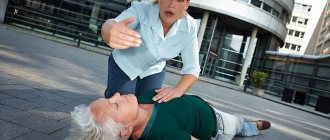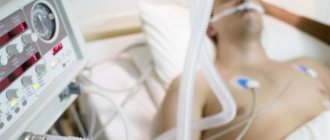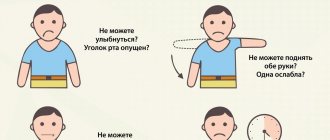Ischemic stroke occurs due to insufficient supply of oxygen with blood to parts of the brain, and hemorrhagic stroke occurs due to excessive supply of blood to the human brain. Both of these diseases are dangerous to health.
After an ischemic or hemorrhagic stroke, one of the complications is impaired motor activity. This places restrictions on the patient's daily life.
Air travel after a stroke should only be done if absolutely necessary, after consultation and permission from a doctor.
Flight specifics
When a person has suffered a stroke, his motor activity rapidly decreases, since the activity of the subcortical centers, which are mainly responsible for coordination, is affected. In this regard, there are certain restrictions for such people, in particular, it is prohibited to fly on an airplane, since this air transport can have a rather ambiguous effect on the human body.
Reference! Flying is prohibited for those who have recently suffered a brain stroke and suffered severe consequences afterwards.
It is important to understand that the decision to allow or prohibit flights should be made only by a doctor who is well acquainted with the characteristics of the patient’s illness.
As for the plane itself, the pressure there always fluctuates. It depends on the amplitude of the aircraft, which is moving at a particular altitude. This factor often leads to a new attack, since the human body has not yet fully recovered from the previous incident.
Symptoms worsen at altitude
At altitude, the typical symptoms of hypertension worsen:
- The occurrence of migraine is a cerebrovascular disease due to prolonged spasm of blood vessels in the head. A dangerous complication is the cerebral form of hypertension (stroke). To prevent arterial hypertension from developing into a malignant form, it is worth defeating migraine at the initial stage.
- The appearance of pressing chest pain. The heart works overtime, so discomfort in the chest may turn out to be angina. If there is a history of myocardial ischemia in hypertensive patients, they should fly with great caution.
- Having severe shortness of breath. Limited space and elevation lead to a feeling of lack of oxygen; reflex shortness of breath may occur in response to stress. To avoid real suffocation, the patient’s breathing must be deep and even; oxygen cocktails can come to the rescue.
- Development of tachycardia. The intense work of blood vessels leads to a rapid heartbeat, because they quickly pump large amounts of blood. This leads to spasm of blood vessels and tension in their walls.
Preparing and facilitating the flight
It is advisable for the patient to prepare himself for the future flight. To do this, the following activities are carried out:
- The blood vessels of the brain are strengthened, medications prescribed by doctors are taken;
- Diagnostic screening is done to identify a possible aneurysm;
- It is imperative to take the prescribed medications; you will definitely need medications against blood pressure and motion sickness;
- A pillow is taken on board to ensure that the passenger is comfortable in the seat. As a result, the load on the cervical spine is reduced.
Air carrier employees must provide official permission to provide an oxygen bag. You can also take antidepressants if your doctor approves.
Often people who have suffered from an illness need blood thinning. For this purpose, special medications are taken.
Attention! It is necessary to avoid drinking drinks with a high content of caffeine and alcohol; it is better to give preference to plain still water; it is recommended to drink a lot of it.
Before the flight, experts advise first putting on compression garments for the comfort of the body. Sometimes the passenger must walk between the rows.
The patient must try to treat his own health with great care and take care of it. When a person feels normal, the doctor cannot prohibit flights. It is important to remember that if you managed to fully recover once, it is unlikely that this will happen again a second time.
What points should be taken into account?
So, what is the opinion of doctors about whether it is possible to fly after a stroke? Typically, attending physicians allow such travel if the following points are taken into account:
- How much time has passed. If more than six months have passed since the operation, but not less than 2 months. It is a big plus if no health-threatening complications arise during this period. That is, after complete recovery from a stroke, you can fly.
- Quality of rehabilitation. The recovery period for the patient was completed successfully, massage and physical exercises were used.
- At what level is your blood pressure? It should be normal, without a sharp rise and fall, the threshold of 140/90 should not be exceeded. Regular intake of prescribed medications is important.
- Is the patient susceptible to aerophobia? Is it possible to fly after a brain stroke if you have a fear of flying? It is extremely important that a person does not suffer from aerophobia, as it provokes severe anxiety and stress.
If all conditions are met and the patient has confidence in his abilities, then he is allowed to fly and is prescribed certain recommendations.
Possible threats
During the flight, people may encounter some difficulties:
- First of all, the position in which the passenger remains for several hours is not entirely comfortable. Since a person is deprived of the ability to move freely, physical inactivity may develop , and this is fraught with the occurrence of blood clots. If the flight takes more than five hours, the passenger's feet become very numb.
- Due to the powerful air conditioning system, there is dry air on board. As a result, the body loses moisture and blood thickening occurs due to dehydration. Doctors recommend replenishing missing moisture reserves exclusively with clean water.
- The distance between the seats on board is quite small . For convenience, it is recommended to bring loose slippers or comfortable shoes to improve blood circulation in the feet.
Possible threats include the following:
- lack of oxygen: when a person has suffered a stroke, all neurons die in the affected area. The cells themselves are susceptible to necrobiosis. If a passenger requires additional oxygen during the flight, they will die;
- Reduced blood pressure: a long flight is stress for blood vessels and the nervous system. In particular, the pressure load increases. The body continually tries to get used to less oxygen. As a result, the heart rate increases noticeably;
- physical inactivity: An immovable position threatens physical inactivity, which results in the formation of blood clots. Even one blood clot in the lower extremities is enough for a relapse to occur;
- fear: fear, or aerophobia as it is also called, is especially dangerous for a patient who suffered a stroke some time ago. The very fact of a long flight frightens a person; this can cause a recurrence of the disease;
- maneuvers and vibration: this leads to heart rhythm disturbances. In addition, if the plane finds itself in a zone of turbulence, the pain in the head intensifies.
Reference! At high altitudes, the air tends to become thinner. This often becomes the main cause of hypoxia.
A stroke survivor may have increased intracranial pressure. The appearance of edema in the brain cannot be ruled out. The corresponding factors are provocateurs of nausea and vomiting.
When stress hormones become active, blood vessels constrict. If their walls are affected by cholesterol plaques, then there is a threat to health. Thick blood leads to clotting, which increases the risk of ischemic stroke.
Against the background of negative emotions, the hormone adrenaline also increases. It causes blood vessels to constrict and pressure to rise. When blood pressure is high, hemorrhagic stroke can occur.
We invite you to watch an interesting video on the topic:
Causes of stroke
The main reason for the appearance of a dangerous pathology is the blockage of one of the brain vessels by blood clots or a foreign object. Blood cannot get through this barrier, which leads to acute oxygen starvation and the death of some cells. This is an ischemic stroke. In a hemorrhagic stroke, an artery ruptures, blood spreads throughout the outer tissue of the brain, and swelling forms, under which cells and nerve fibers die.
Types of stroke
Despite the fact that this pathology is extremely dangerous to human health and ends in death in half of the cases, medical care can save the patient’s life. Within 3-4 hours after a stroke, the patient should be placed in the intensive care unit, and in some cases, operated on by a neurosurgeon. The less time spent on the journey to the hospital, the higher the patient’s chances of surviving and not becoming disabled after a stroke. However, much depends on the area of the affected area of the brain: serious complications cannot be avoided if the area is too large.
If the operation is successful, the patient faces a long and difficult rehabilitation period ahead. As practice shows, most people who have suffered a stroke have to relearn how to live: walk, count and write, and treat the negative consequences of a stroke. On average, the patient returns to normal life 2 months after the stroke. It takes much more time to start working again, drive a car, or travel on business to other cities and countries.
Stroke and airplane travel
Often, patients who have suffered a stroke, whose life was completely or partly connected with travel, ask doctors: “Is it possible to fly on an airplane after a stroke?”
Types of coronary artery bypass grafting
At the moment, there are different options for surgical operations:
- Open surgery through an incision.
- Minimally invasive intervention through small incisions.
- TECAB operation using the Da Vinci Robot.
Open operations (through an incision)
Such interventions are performed through a large incision about 25 cm long. The operation can last from 3 to 6 hours, depending on the number of blocked arteries. Open intervention is performed in one of two ways:
- The classic method is using a heart-lung machine (ACB). In this case, the patient’s own heart is stopped during bypass and connected to a special device that ensures blood circulation. After surgery, the device is turned off and the patient's heart starts beating again. The use of heart-lung machines can lead to certain complications: kidney failure, problems with blood clotting, and memory impairment.
- Bypass surgery can also be performed on a beating heart. Such operations are more complex and require the surgeon to have certain experience and skill. But the risk of complications is significantly lower.
Despite the fact that modern surgery is focused on minimally invasive interventions, in case of coronary heart disease, in some cases, open surgery becomes the only option. For example, it is used if blood flow in one of the large arteries is disrupted, or several vessels are blocked.
During open surgery, the bones of the chest are cut, and then metal staples are installed to ensure that they fuse successfully.
Advantages: With a large incision, the surgeon has access to the desired area of the heart and can better control the process.
Disadvantages: risk of bleeding, wound infection, high trauma, long recovery period.
Minimally invasive surgery
During such an intervention, the surgeon makes small (7–8 cm) incisions in the intercostal spaces and performs a bypass through them. In most cases, such operations do not require the use of heart-lung machines. Endoscopic interventions are usually used when the coronary arteries at the front of the heart are blocked.
Advantages: minimal tissue trauma and blood loss, small incisions, short rehabilitation period - the patient recovers approximately 2 times faster than after open interventions.
Disadvantages: minimally invasive operations are more complex, require a more highly qualified surgeon, and cannot always be performed.
Robotic operation TECAB
Bypass surgery using the Da Vinci robot is “keyhole” surgery. Punctures about 1 cm in size are made in the patient's chest wall, and a video camera and special instruments are inserted through them. Surgeons control the robot’s “arms” using a remote control and see what is happening on the screen.
During endoscopic operations, instead of a heart-lung machine, stabilizers are used - devices that allow stopping the work of only the part of the heart where the intervention is performed.
Advantages: this type of bypass surgery is the least traumatic, after which patients recover quickly (they can be discharged from the hospital after three days) and return to their normal lives.
Disadvantages: not all clinics have equipment for such interventions and doctors who know how to work with it. Robotic surgery is not suitable for all patients. One of the most important factors determining whether TECAB can be used is the location of the blocked artery.
Long sitting position
Passengers on the plane remain motionless for a long time. Physical inactivity can cause blood clots, resulting in a recurrent stroke. This possibility will be higher the longer the flight lasts. Flights typically last more than five hours, so passengers often experience swollen feet.
Wearing compression garments under regular clothing will help prevent this. Women can buy special compression tights. They will disperse the blood where it stagnates. Sometimes it is acceptable to get up from your seat at least once and walk around the salon, of course, when this is not prohibited. To disperse blood throughout the body, it is good to rotate your hands, feet and neck. In general, simple health-improving exercises will help.










